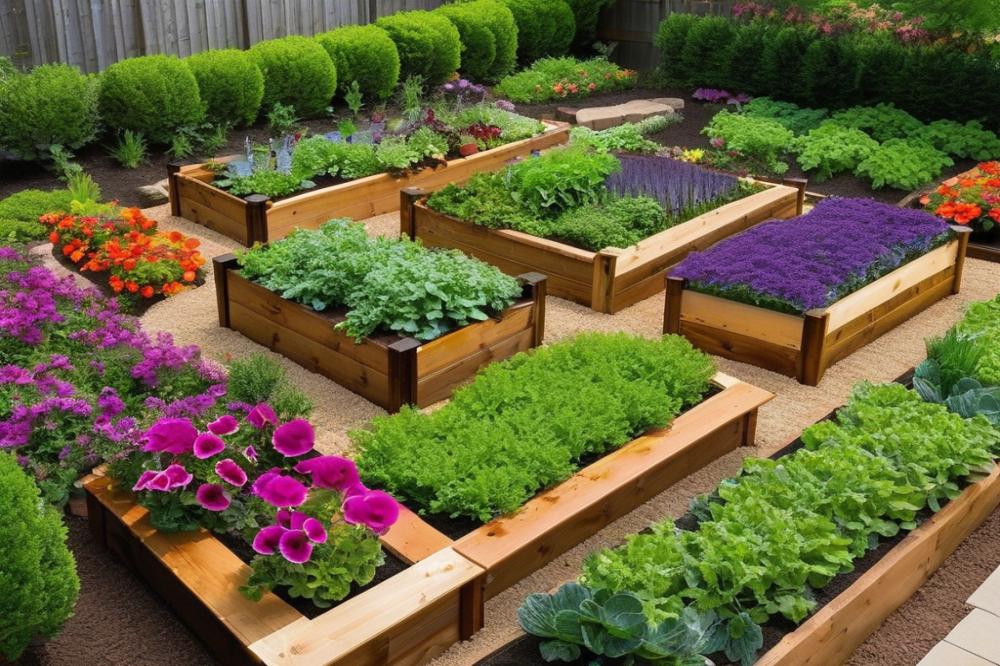fertilizers-in-drought-prone-gardens”>fertilizing techniques for fertilizers-improve-soil-structure-and-nutrient-availability”>raised garden beds
raised garden beds have gained popularity among gardeners of all skill levels. The structure allows for better drainage and easier access, making planting and maintenance more manageable. Gardeners appreciate how these beds create a defined space for cultivation, leading to healthier crops. Soil temperature tends to be warmer due to their elevated nature, which can hasten plant growth in cooler months. Adding these features together means gardeners enjoy an abundance of crops with less effort.
Fertilization plays a crucial role in maintaining healthy plants in any garden setting. In raised garden beds, the soil can become depleted of nutrients more quickly than in traditional gardens. This happens because the confined space concentrates crop growth and shortens the lifespan of essential nutrients. Using organic fertilizers and compost can replenish what’s missing. Soil amendments also contribute to the nutrient balance, creating an environment ripe for plant growth.
This article aims to highlight effective fertilizing techniques tailored for raised garden beds. Readers will learn about the importance of seasonal fertilization and how soil testing can inform their approach. Strategies for enhancing microbial activity in the soil will be discussed, showcasing methods to improve overall health. Crop rotation will be examined to ensure nutrient replenishment is consistent. With the right practices in place, gardeners can achieve thriving plants that maximize growth and yield. By understanding these concepts, anyone can cultivate a successful raised garden bed.
Understanding Soil Needs in Raised Garden Beds


Healthy soil is a fundamental factor in successful plant growth. Without it, even the best gardening practices may yield poor results. Soil health affects everything from root development to nutrient absorption. Plants rely on their soil for essential nutrients, water retention, and a habitat for beneficial organisms. A balanced nutrient supply helps them thrive and produce bountiful crops.
Importance of Soil Testing for Nutrient Balance
Conducting soil testing is a critical step for any gardener. This process provides an accurate assessment of nutrient levels and pH balance in the soil. Testing results guide decisions regarding which organic fertilizers or soil amendments to incorporate. Not only does this help with immediate plant needs, but it also promotes long-term soil vitality. Test your soil regularly, ideally before the planting season, to establish a solid foundation for growth.
Identifying Soil Deficiencies and Amendments Needed
Deficiencies in soil can hinder plant development. Common symptoms include stunted growth, discoloration, or poor yields. If you notice these signs, it may indicate a lack of vital substances like nitrogen, phosphorus, or potassium. Once identified, amendments can be applied. compost enriches the soil over time and enhances microbial activity. Crop rotation is another technique that prevents nutrient depletion. Adjustments can be made seasonally to address specific crop needs or repair soil quality.
Enhanced water retention can be achieved by mixing in organic matter. This also fosters a thriving ecosystem within the soil, where earthworms and other organisms help aerate and process matter. Each type of soil has its unique properties, so get to know yours well. When deficiencies arise, addressing them promptly is crucial for maintaining optimal growth conditions in your garden.
Types of Fertilizers for Raised Garden Beds


Difference between organic fertilizers and synthetic options
Organic fertilizers come from natural sources like plant or animal matter. Examples include compost, bone meal, and fish emulsion. These options release nutrients slowly, contributing to long-term soil health. In contrast, synthetic fertilizers are chemically manufactured. They often provide a quick nutrient boost but can disrupt soil life over time. The choice between these two can significantly affect plant growth. While synthetic fertilizers can deliver immediate results, organic alternatives foster a balanced nutrient environment.
Benefits of using organic fertilizers
Using organic fertilizers has multiple advantages. They enhance microbial activity in the soil, which helps break down organic matter. This process ultimately improves soil structure and boosts water retention. Nutrient balance is also better achieved with organic practices. Crops grown with organic fertilizers often have a higher nutritional content. These fertilizers also reduce the risk of chemical build-up in the environment. Because of their natural origins, they promote sustainable gardening practices. Observing seasonal fertilization strategies can align well with organic methods, ensuring that the soil remains rich.
Application of compost in raised garden beds
Compost acts as a powerful soil amendment, rich in nutrients. Initially, it can be spread as a top dressing or mixed into the soil before planting. This process enriches the growing medium while enhancing its texture. Creating compost requires using kitchen scraps, yard waste, or other organic materials. Over time, these materials break down into a dark, crumbly substance. Testing the soil helps determine how much compost is needed for optimal crop yields. Regularly adding compost improves both nutrient availability and soil structure, leading to healthier plants. Crop rotation can also be complemented by compost application, supporting diverse plant growth.
Best Practices for Applying Fertilizers


Timing and Methods of Seasonal Fertilization
Applying fertilizer at the right time is crucial for plant health. Spring marks an important period when plants are waking up. During this season, consider using organic fertilizers, as they release nutrients slowly. This gradual approach helps plants absorb what they need without overwhelming them. Fall also provides an opportunity for fertilization. Adding compost in late fall can enrich the soil and prepare it for winter. Layering organic material on top of the soil promotes nutrient cycling.
Importance of Water Retention in Raised Garden Beds
Water retention plays a significant role in plant health and development. Well-watered plants thrive, so maintaining moisture is essential. High-quality soil amendments improve drainage while enhancing water-holding capacities. Raised garden beds can dry out quickly due to their elevated structure. Adding mulch around plants can prevent moisture loss. This simple practice helps sustain optimal growing conditions, allowing for a healthier garden.
Adjusting Fertilization Based on Plant Growth Stages
Every stage of growth demands different nutrient levels. As seedlings emerge, they require less fertilizer than mature plants. Early in the growth cycle, focus on boosting microbial activity in the soil. This supports root development and the initial establishment of young plants. As plants mature, the need for balanced nutrients increases. Monitoring plant growth provides valuable insights. Conduct soil testing periodically to understand nutrient deficiencies. Crop rotation can also affect fertilization needs, offering a fresh approach each season. Adjusting fertilizer application keeps gardens productive and vibrant throughout the growing season.
Utilizing Soil Amendments


Types of Soil Amendments Suited for Raised Beds
Many options exist when choosing soil amendments for planting. Organic fertilizers like bone meal and blood meal enrich the soil effectively. Compost is another choice that provides nutrients and improves overall structure. Additionally, materials such as peat moss and perlite enhance aeration and water retention. Each type of amendment serves a specific purpose. For instance, lime can raise pH levels for plants that prefer alkaline conditions.
How Soil Amendments Enhance Microbial Activity
Healthy soil is alive with activity. Microbial life plays a crucial role in breaking down organic matter. Soil amendments foster an environment where beneficial microbes can thrive. They break down complex substances into simpler forms that plants can absorb more easily. Ample microbial activity helps in processes such as nutrient cycling. This means nutrients become available to plants over time, promoting robust plant growth.
Incorporating Amendments for Improved Nutrient Uptake
Proper incorporation of amendments can make a significant difference in garden success. A good rule of thumb is to mix amendments into the top few inches of soil before planting. Seasonal fertilization can help maintain nutrient balance throughout the growing period. Soil testing is recommended to identify specific needs. Ensuring the right mix allows plants to access the nutrients they require for healthy development. Crop rotation can also work alongside amendments to enhance soil quality and plant vitality. Combining these strategies leads to a flourishing garden.
Crop Rotation and Its Impact on Fertilizing
Understanding Crop Rotation in Raised Garden Beds
Crop rotation involves planting different types of crops in the same area across seasons. This technique helps to break cycles of pests and diseases. By altering the crops, gardeners can promote a diverse ecosystem. Certain crops enrich the soil, while others deplete it. Planting different species can help maintain a healthy balance of nutrients.
Benefits of Crop Rotation for Soil Health and Nutrients
One significant advantage of crop rotation is its impact on soil health. Rotating crops can enhance microbial activity in the soil. This activity boosts organic matter, which contributes to better water retention. Furthermore, different plants have varying nutrient needs. Some crops, like legumes, can fix nitrogen in the soil. This natural process improves fertility without synthetic inputs. Utilizing compost alongside rotating crops can maximize the benefits. It complements the crop cycle by replenishing lost nutrients and enriching the soil structure.
Strategies for Effective Crop Rotation
Planning is crucial for successful crop rotation. Start by grouping plants into families based on their nutrient needs. For instance, nightshades like tomatoes and peppers should not follow each other because they share the same nutrient demands. Incorporating cover crops during the off-season can also be beneficial. These plants can prevent soil erosion and improve nutrient balance. Seasonal fertilization should be aligned with the specific needs of the crops in each rotation phase. Regular soil testing can provide valuable insights into nutrient levels and deficiencies. This knowledge helps gardeners tailor their organic fertilizers and soil amendments effectively. Overall, thoughtful crop rotation leads to healthier plants and more productive gardens.
Maintaining Nutrient Balance
Monitoring the nutrient balance in your garden is essential for healthy plants. One way to achieve this is through regular soil testing. Testing your soil provides a clear picture of what nutrients are already present and what might be lacking. The right balance encourages optimal plant growth while preventing nutrient deficiencies.
Monitoring and Adjusting Fertilizer Applications
Adjusting your fertilizer applications can lead to thriving plants, particularly in raised garden beds. Start by using organic fertilizers, which improve soil health over time. It’s advisable to apply these fertilizers during specific growth phases of your plants. Pay attention to the results after each application. Keeping a garden journal may help track how plants respond to nutrients.
Signs of Nutrient Deficiencies or Excesses
Identifying nutrient deficiencies involves observing your plants closely. Yellowing leaves can indicate insufficient nitrogen, while stunted growth may point to a lack of phosphorus. On the flip side, nutrient excesses can also cause problems. Leaf burn or wilting may suggest over-fertilization. Observing these signs is essential for timely adjustments, allowing for better health in your garden.
Long-term Strategies for Maintaining Nutrient Balance
Utilizing compost and soil amendments can naturally boost nutrient levels. Regular crop rotation is another effective strategy. Rotating your plants helps replenish nutrients naturally while minimizing pathogen buildup. Incorporating organic matter can enhance water retention and boost microbial activity, which is vital for nutrient cycling. Additionally, seasonal fertilization routines will support ongoing soil health.
Final Thoughts on Fertilizing Techniques for Gardening
To recap, various strategies can greatly enhance your plants’ growth and health. Incorporating organic fertilizers is a fantastic way to boost nutrient levels. Regularly adding compost can improve soil structure and water retention. Using cover crops between growing seasons can also enrich the soil. These methods provide the necessary nutrients while promoting a balanced ecosystem in your garden.
Experimenting with different fertilizing techniques is key. Gardens are unique, and what works for one may not work for another. Try various combinations of nutrients and observe how your plants respond. Track changes to determine what leads to increased growth or yields. This trial and error can be a fun and educational part of gardening.
Improving soil health is crucial for vibrant plants. Healthy soil results in stronger root systems and better yields. Remember, a thriving garden is not just about the plants above ground, but also about what happens beneath the surface. Invest time in understanding your soil’s needs. Your dedication will pay off with lush, productive greenery.



